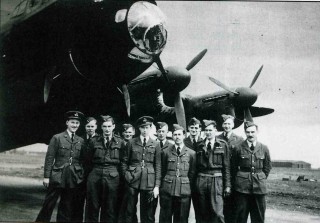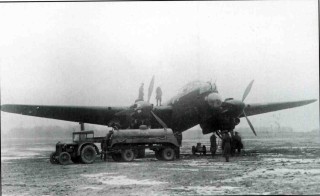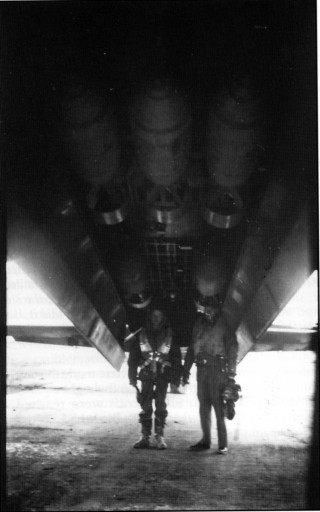Chapter 4: ... a Piece of Cake
On the Wings of the Morning
Vincent Holyoak
Given the Manchester’s reputation, it was with some relief that on January 16th a third flight was formed on 207 to begin converting crews onto the Lancaster. After 44 at Waddington, 207 would be only the second squadron to receive the aircraft, basically an uprated Manchester. This redesign had entailed increasing the aircraft’s wingspan to incorporate the two extra powerplants and retaining the larger tail section as fitted to the last production Manchesters. Inside there were a few other differences. Most noticeable was the fact that, unlike the Manchester, the Lancaster did not have dual controls. Conversion consisted of familiarising pilots and co-pilots with slightly altered systems layouts, improved performance characteristics and new handling procedures, and was carried out on the first production Lancaster BT308. Having begun life as a Manchester, BT308 still retained its dual controls and was invaluable for initial training, although its bright yellow ‘test aircraft’ colour scheme presented a stark contrast to the sooty black Manchesters. The first two full production Lancasters were not delivered until the end of January, and from then on ‘C’ Flight’s work began in earnest under the direction of Flight Lieutenant Peter Ward-Hunt, who had recently completed his second tour.
Nevertheless, if the crews thought that February was to bring them either the promise of better weather or a release from the campaign against German shipping, they were disappointed. The weather for the first few days of the month was again so bad that little flying was undertaken, but on the 4th it cleared sufficiently for three aircraft to be sent to drop mines in the shipping lanes around the Frisian Islands. Deteriorating conditions forced the crews to return early, but the fact that the operation was mounted at all indicates the seriousness with which intelligence reports were being taken, warning of the imminent break-out of the Scharnhorst, Gneisenau and Prinz Eugen from Brest. Like other 5 Group squadrons, 207 therefore had six Manchesters kept at permanent readiness on the rain- and windswept apron, ready fuelled and armed with 2,000 lb Armour Piercing bombs, the only ordnance likely to be able to penetrate the heavily armoured decks on the cruisers.
Over the next two weeks fog and low cloud enshrouded Bottesford, but they were still trying times for the air and ground crews kept at readiness in anticipation of a change in conditions. As it happened, 207 was not called upon until the 11th, when one crew was sent minelaying off the Frisians and six others to bomb Mannheim. Technical problems and the weather ensured that the returning aircraft were scattered across several aerodromes. Only one actually managed to return to Bottesford with what were to prove unfortunate consequences, because in the early hours of February 12th the Scharnhorst, Gneisenau and Prinz Eugen finally slipped their moorings and headed out into the Channel under heavy escort. The same low cloud and heavy squalls which had caused problems for those attacking Mannheim provided perfect protection for the ships. The whole of 5 Group had been on four hours’ readiness in anticipation of just such a turn of events, but the three cruisers were not spotted until 10.42 in the morning, and from then on the teleprinter messages flew thick and fast ordering every available aircraft into the air.
There were two problems at Bottesford. Firstly, the number of aircraft available had been reduced by the diversions the night before, and secondly, those on stand-by were still loaded with 2,000lb Armour Piercing bombs. Since the only means of sighting the ships would be to get beneath the cloud base which extended as low as 500 feet, it was obvious that at this altitude the bombs would not gain enough velocity to pierce the armoured decks, so six aircraft were hurriedly re-loaded with twelve 500 lb General Purpose bombs apiece. The six aircraft concerned were L7455 and L7486 from the Conversion Flight, L7488 and L7432 which had been on stand-by and L7432 and L7515 which had now returned from their diversionary aerodromes. Of the six L7432 and L7515, allotted to Wing Commander Fothergill and Flying Officer J.H. Leland, became unserviceable just before take-off, and Squadron Leader Thos Murray’s L7485 developed a serious hydraulic leak just as he was climbing away from the aerodrome. He landed back after just seven minutes, leaving the three others to continue. Of these, Peter Ward-Hunt and Peter Birch, both instructors from the Conversion Flight, soon became lost in the impenetrable ‘clag’ and could not locate the ships, and only Flight Sergeant Johnny Atkinson had any luck. For a fleeting moment the clouds parted, the Prinz Eugen was sighted, and from only 800 feet his observer straddled the ship perfectly with his bombs. In reply they received a hit in the tail from heavy flak and limped away into the welcoming murk. The cruiser sailed on obliviously. If she was hit, the bombs had simply bounced off her deck.
Following the ineffectiveness of these attacks, a mining sortie was mounted in the evening, but the squadron was again dogged by bad luck. Of the four crews despatched only Pilot Officer Doble was able to ‘sow his vegetables’ successfully. Thos Murray in L7485 was unable to release his mines because of a hydraulic failure, the same ailment which had grounded him that afternoon. For the armourers it had also been a frustrating day. Some had been on duty for 48 hours, sleeping fitfully when they could, and the conflicting orders from Group with the evening’s mining sortie effectively meant that the aircraft had been loaded three times in less than 24 hours. Because of mechanical faults L7485 and L7515 had been loaded, unloaded, re-loaded and then unloaded again in less than twelve hours! The one ray of light was that as the Scharnhorst and Gneisenau passed through the Frisian Islands on the final leg of their journey, both had struck air-sown mines. Although not catastrophic, this and the damage already inflicted whilst in Brest meant that they would remain inactive until further repairs were effected. Not only had they been prevented from returning to the Atlantic, but wherever they were forced to dock they would again be open to air attack.
As the snow fell on the afternoon of Saturday 21st February, 5 Group Headquarters at St.Vincents in Grantham cancelled a planned gardening sortie and the crews were gratefully stood down. However, as the evening wore on conditions improved enough for two aircraft to be readied for a smaller scale mining operation off Wilhelmshaven. Flight Sergeant Coles took off at 2038 hours, closely followed by ‘Prune’ Leland. Both landed back around two o’clock the following morning to report heavy icing, snow flurries and extremely poor visibility. With no horizon to guide them, flying had been on instruments, requiring intense concentration and extremely dangerous because the mines had to be dropped from 700 feet or below. At such a low altitude even a few seconds disorientation might be fatal. To make matters worse the icing made both radio communication and aircraft handling difficult. Unable to identify the target area, they had returned to Bottesford with their four 1,500 lb mines and made hazardous landings on the icy runway. Meanwhile, four other crews were anxiously waiting in the draughty Flight Office as the take-off time for their own operation was again postponed.
They had been called to readiness early the previous morning and had spent a miserable day wondering what could possibly be in store for them in such weather. They were not briefed until the afternoon, miserably tramping down to the operations block in the snow. The briefing did not cheer them any. Following the breakout from Brest the Prinz Eugen had sailed for Brunsbuttel from where she was ordered to Norway along with the pocket battleship Admiral Scheer. However, just south of Trondheim the Prinz Eugen had been torpedoed by the Royal Navy submarine Trident, forcing her to limp into a nearby fjord for repairs. The fact that the ship was now effectively trapped in the fjord made an air attack feasible, for which reason the carrier HMS Victorious was steaming northwards with the intention of launching her aircraft against the cruiser. The one major problem was the heavy Luftwaffe fighter presence in the area, so Bomber Command was tasked with attacking the four main German airfields. The comforting idea was that if they didn’t actually succeed in destroying many fighters on the ground, they would at least create a diversion. Three 207 crews were therefore assigned to attack the Luftwaffe airfield at Sola, a mission which would be carried out at the limit of endurance for their aircraft, in appalling weather and against strong opposition.
And so they waited, anxiously peering outside and hoping for a ‘scrub’, but within an hour of the return of the two gardening aircraft they were at last told to prepare for take-off. Three of 207’s most experienced captains had been chosen, but it had been an extremely long day, and as they reached their dispersals it began to snow again. Taxiing a fully loaded bomber in good weather was no easy matter. The long nose obscured vision and the pilot had to gun the engines and constantly fish-tail from side to side to obtain a better view as he taxied out onto the narrow perimeter track. At 0330, in a flurry of snow kicked up by his propellers, ‘Dim’ Wooldridge in EM-P L7484 over-corrected slightly and put a wheel off the hard standing. With full tanks and six 1,000 Ib bombs on board P-Peter was stuck fast and could not be moved. Twenty-two minutes later Dave Green in K-King made a successful take-off run using the whole length of the runway, to be followed into the murk by Penny Beauchamp in B-Beer.
Things already looked grim, but the additional delay in take-off effectively meant that they would now be flying over enemy territory in daylight. It was obvious on the ground that the weather was not improving as predicted. With the continuing snowfall the crews would surely be experiencing problems with icing. The Manchesters would become heavier and the controls sloppy as the mantle of ice built up around them. Their engines would be straining with the increased load and radio contact would be lost. For this reason the recall signal was transmitted at 0500. Penny Beauchamp jettisoned his bombs and cautiously set course back to Bottesford with a frozen air speed indicator, but Dave Green’s wireless operator did not receive the faint Morse signal and they carried on. However, some time later his navigator Goldie Goldstraw detected a change in wind direction, and a check on the fuel told them that they had insufficient left to attack Sola and return to Britain. They too turned back. They eventually landed back at 1024 hours, physically shattered, to discover that the attack on the Prinz Eugen had been a similar failure due to the appalling conditions. The one consolation was that, for once, the aircraft had held up wonderfully.
The bad luck could not last for ever and on March 3rd the Squadron was called upon to take part in a raid on the Renault works at Billancourt, to the west of Paris, where lorries were being produced for the Wehrmacht. The operation was a problematic one because although efforts could be made through the Resistance to warn workers of an impending attack, any truly effective warning would also alert the Germans. Added to this were the civilian houses which surrounded the factory. French casualties would be impossible to avoid. 207 was to provide seven crews, and the attack was to be made in three parts, flares being dropped by the first wave to clearly mark the target for those who followed. This was then a novel tactic, but its success would cause it to become widely used in the future. Two hundred and thirty five aircraft were to take part, making this the largest raid of the war so far and a turning point in the fortunes of Bomber Command. The 207 aircraft lifted off from Bottesford around six o’clock in the evening. The weather was perfect. Over France it was a clear, starry night, the River Seine shining in the strong moonlight. Sergeant George Hawes, the 26 year-old Australian second pilot on Johnny Atkinson’s crew, gave a vivid account of the raid in a letter home to his parents:
It was an absolutely wizard show, and we blasted the place off the face of the map. We were the second wave to go over, and when we arrived the place was lit up by hundreds of flares and the target was a mass of flames. On the run-up we counted sixteen huge fires burning in the target area. We attacked as low as we could without getting the blast from our own exploding bombs. You can’t imagine the satisfaction one gets from actually seeing your bombs land smack in the centre of the target and pieces of factory torn from the ground and thrown hundreds of feet into the air. It was the best night’s work I have ever done. A great show, and as the boys say, ‘a piece of cake’.
The navigator on board Peter Ward-Hunt’s aircraft, Flying Officer Plaistow, had no problem identifying the target as he had worked at Billancourt before the war. As he watched the raid unfolding before him, it must have been with mixed feelings. The Renault factory was heavily damaged but French casualties were severe, proving that pin-point accuracy was still impossibly elusive.
Between the 8th and 11th March three raids were launched in as many nights against Essen, deep within Germany’s heavily defended industrial heartland, the Ruhr, ironically referred to by the crews as ‘Happy Valley’. On the night of the 8/9th the first of the Essen force to take off was Flight Lieutenant Peter Birch in EM-G. With him acting as observer was Group Captain Swain. Engine trouble soon forced them to abort, but Frank Roper, a good friend of Birch’s recalls:
Some time during the trip Swain asked where the Elsan toilet was, and one of the smart crew members flipped 011 his microphone and said ‘Straight dowll the back of the aeroplane, sir, first door on your left. Watch your step!’, the step in question being 6,000 feet! We never could pin down the person who said it, it was taken as a joke anyhow, but we were pretty sure it was Sammy Hall that did it – he was that kind of guy – a fun man!
As usual, the Ruhr’s notorious industrial haze made the target, the Krupps works, difficult to identify. The third raid on the night of the 10/11th March was another disappointment. Six aircraft were readied, but Ginger Hathersich’s aircraft, L7455 in which Peter Birch had been forced to abort two nights before, again developed engine trouble, this time just before take-off. Of the remaining five Manchesters, Squadron Leader Beauchamp was forced to return within minutes due to failure of his port engine, and Pilot Officer John Speir RCAF returned three hours later with the same problem. This left Johnny Atkinson, ‘Babe’ Ruth and Frank Roper (now on his fifth operation as captain) to continue to the target. Here they found cloud, unpredicted at briefing, with the result that post-raid reconnaissance showed bombing to be extremely scattered.
When Frank Roper touched down Manchester L7485 ‘D-Dog’ at 0330 hours on the morning of Wednesday March 11th 1942, he had completed what was to be 207 Squadron’s last Manchester operation of the war. For the next few weeks the Squadron was stood down from operations whilst its crews converted on to the Lancaster. For the Manchester it was an inauspicious end to an inauspicious career, but if the aircraft exhibited one of the most dangerous characteristics of any aeroplane, mechanical unreliability, it also brought out the best in the air and ground crews who had contend with it.












No Comments
Add a comment about this page